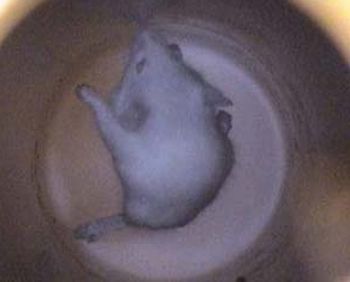Circa 2009
(PhysOrg.com) — Scientists have managed to levitate young mice in research carried out for NASA. Levitated mice may help research on bone density loss during long exposures to low gravity, such as in space travel and missions to other planets.
The researchers worked from a number of laboratories around the U.S., including the Jet Propulsion Laboratory in Pasadena, California and the University of Missouri. The research was done on behalf of NASA, and was published in the online journal Advances in Space Research on 6 September 2009.
The scientists built a variable gravity simulator consisting of a superconducting magnet that could generate a magnetic field strong enough to levitate the water inside every cell in the mouse’s body. Water is weakly diamagnetic, which means that in the presence of a strong magnetic field the electrons in water rearrange orbit slightly, creating tiny currents in opposition to the external magnetic field. If the external magnet is strong enough, the diamagnetic repulsion of the water in the mouse tissue is enough to exactly balance the force of gravity on the body.
